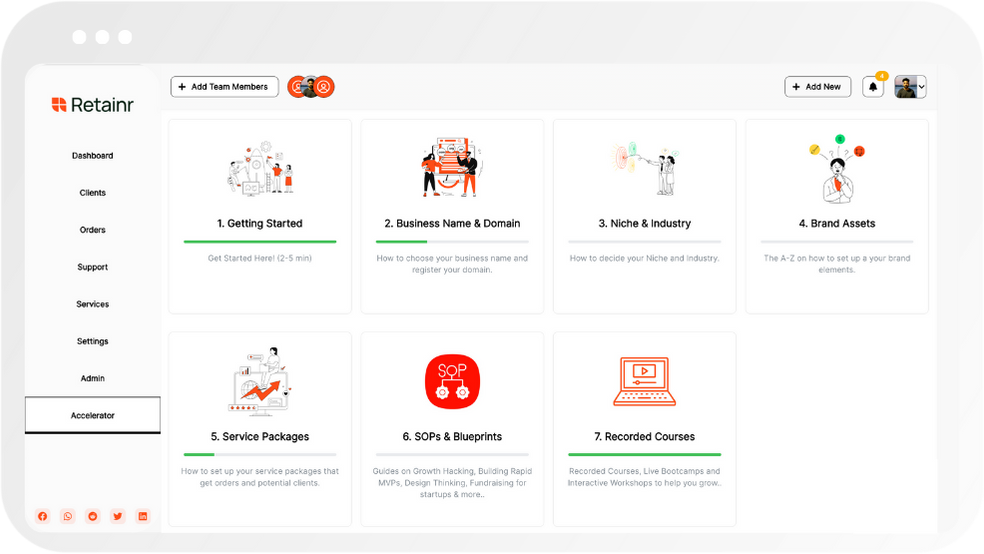
5 Essential Habits for Highly Productive Teams
Build with Retainr
Sell your products and services, manage clients, orders, payments, automate your client onboarding and management with your own branded web application.
Get Started1. What are the 5 essential habits for highly productive teams?
Essential Habits for High Productivity
Every successful team has a set of habits they engage with for increased output and overall productivity. While different teams might prioritize different aspects, there are some universal habits that can immensely improve a team's productivity level. These five essential habits can transform any group into a highly productive team:
- Goal Setting: Setting clear, attainable goals creates focus and provides members with specific targets to aim for.
- Effective Communication: Clear and frequent communication prevents misunderstandings and encourages collaboration.
- Regular Feedback: Regular constructive feedback helps team members to improvise and learn from their mistakes.
- Conflict Resolution: Healthy conflict resolution not only resolves issues but also strengthens team harmony and cooperation.
- Continuous Learning: Pursuing continuous learning cultivates innovation and encourages individuals to keep up with current trends.
Applying the Five Habits
In order to fully leverage these habits, each one must be generously practiced within the team. Here's a simple table to demonstrate how to apply these habits:
| Habit | Application |
|---|---|
| Goal Setting | Define clear objectives for each team member and provide deadlines for tasks. |
| Effective Communication | Encourage open discussion and actively involve everyone in decision-making processes. |
| Regular Feedback | Conduct routine performance reviews, and provide room for self-assessment and peer-feedback. |
| Conflict Resolution | Encourage a mentality of problem-solving over blame, and promote acceptance of differing opinions. |
| Continuous Learning | Organize regular training sessions, provide resources for upskilling, and encourage individual research and learning. |
2. How can a team implement these 5 essential habits into their work routine?
Implementing Essential Habits in a Team Work Routine
Increasing team productivity involves adopting effective habits that promote synergy and foster clear communication. The first of the 5 essential habits is adopting a shared vision. This vision should align with the organization's goals and can be integrated into the work routine through regular team meetings and interactive sessions to brainstorm and discuss ways to achieve this vision. The second habit, developing a feedback culture, can be embedded in the team's work routine by setting aside time for constructive criticism and creating platforms, like suggestion boxes or online forums, for members to voice their opinions.
Daily Schedules and Regular Breaks
The third habit is optimizing work processes using tools, like project management apps, to schedule tasks, reduce time wasted on unnecessary activities and improve efficiency. A regularly updated schedule creates transparency and ensures all team members are aware of what needs to be done. The fourth habit is taking regular breaks. Breaks are not just for relaxing, but also for disconnecting from work-related stress and reinvigorating the mind. Teams can schedule short breaks after completing certain tasks or during specific times of the day.
Acknowledging Achievements and Fostering Positivity
The fifth habit is acknowledging individual and team achievements. This involves rewarding hard work and recognizing effort, which can be done in weekly team meetings or on a company's online platform. Along with these 5 habits, it is important for teams to foster positivity. This extends beyond simply having a positive attitude and includes creating a positive environment with open communication, mutual respect, and understanding. A positivity plan could involve scheduled stress-busting activities or ensuring the team operates in a clean, bright and comfortable environment.
| Habit | Implementation Strategy |
|---|---|
| Shared Vision | Regular meetings and interactive sessions |
| Feedback Culture | Constructive criticism sessions and suggestion boxes |
| Optimising Work Processes | Use of project management tools |
| Regular Breaks | Scheduled breaks after task completion |
| Acknowledge Achievements | Recognition in team meetings or on the company’s platform |
| Fostering Positivity | Scheduled stress-busting activities and a comfortable environment |
3. Can you provide examples of successful teams that embody these 5 essential habits?
Example 1: Google's teams
Google's teams are a perfect example of highly productive teams and they’ve long been known to embody the 5 essential habits. Firstly, the teams always make sure to define their shared vision, as shared in their re:Work guide.
- Google teams lead the healthy culture of delegation and responsibility. Developers are involved in deciding what features the software will have.
- They are also excellent at embracing diversity. Gender, racial and ethnic diversity are known to enhance innovation within Google teams.
- Open communication is another aspect Google highly maintains. Google's weekly TGIF meetings are organized to discuss products and policies.
- Google is known for its continuous skills development by providing various resources like training and workshops.
- The Google team embraces challenges to foster innovation.
Example 2: Amazon's teams
Another example of successful teams embodying these habits is Amazon. They have made it clear in their leadership principles that they focus on these 5 habits for a productive team.
| Habit | Examples |
|---|---|
| Delegation | Employees are given ownership and autonomy to make decisions. |
| Embracing diversity | Amazon’s employees come from different nations and cultural backgrounds. |
| Open communication | Amazon follows an open-door policy, where employees can communicate freely. |
| Skills development | Amazon invests $700 million in employee upskilling programs. |
| Embraces challenges | Amazon commits to long-term initiatives with audacious goals. |
Example 3: Microsoft's teams
Microsoft's teams have also consistently embodied these 5 essential habits for productive teams.
- Microsoft is renowned for delegation, with specific roles assigned to everyone involved.
- They show value in embracing diversity, as reflected in their diverse workforce and inclusive mission statement.
- The organization encourages open communication through their regular company-wide town-hall meetings.
- They place a high emphasis on skills development, with extensive learning resources and platforms available to their employees.
- Finally, Microsoft always embraces challenges, evident by their constant advancements in technology and innovation.
4. Are these habits scalable for larger teams and organizations?
Scalability of Essential Habits for Larger Teams and Organizations
The five essential habits for highly productive teams can be easily scaled for larger teams and organizations. Whether you're dealing with a team of ten or a multinational organization with thousands of employees, these habits are designed to boost productivity at any scale.
- Clear Communication: This habit can actually become more important as the team grows larger. Larger teams require even more clarity and precision in communications to prevent misunderstandings.
- Accountability: When there are more team members, making sure everyone takes responsibility for their actions becomes even more crucial.
- Goal Alignment: This habit ensures that everyone in the organization, regardless of its size, understands and works towards the same goals.
- Empowerment: Emphasizing individual empowerment can lead to increased productivity across a large organization.
- Continual Learning: A culture of learning helps organizations, large and small, to adapt to changes and continually improve.
Bellow, a table summarizing how to implement these habits in larger teams and organizations.
| Essential Habit | Implementation in Larger Teams/Organizations |
|---|---|
| Clear Communication | Implement communication platforms that support mass messaging and department-specific channels. Consider regular all-hands meetings for direct communication from leadership. |
| Accountability | Establish clear roles and responsibilities. Use project management tools to keep track of tasks and progress. |
| Goal Alignment | Clearly articulate company objectives. Ensure every project and task aligns with these larger goals. |
| Empowerment | Provide opportunities for professional development. Encourage autonomy and reward initiative. |
| Continual Learning | Provide resources for skill development. Encourage cross-departmental knowledge sharing. |
5. What challenges might teams face when trying to adopt these essential habits?
Challenges in Adopting Essential Productive Habits
Teams may face several challenges in trying to adopt these essential habits for productivity. One of the key challenges includes resistance to change. As humans, we are creatures of habit and tend to oppose the changes, especially when we are comfortable with our current behaviors and routines. Such resistance can slow down the process of adopting new, productive habits. Similarly, another potential challenge could be lack of commitment within the team, which can render these essential habits ineffective.
- Resistance to change: Teams need to overcome their inherent resistance to change to adopt new productive habits. However, this could be an uphill task, especially if the team members are comfortable with their current routine and behaviors. Continuous insistence and motivation can help overcome this resistance.
- Lack of commitment: The success of any habit adoption process largely depends on the commitment levels of the team members. If they are not committed to the changes or the goals set out, the process can easily fail. Effective communication and reassurances can help foster commitment within the team.
- Inefficient communication: Effective communication is key in ensuring that all team members are on board with the habit adoption process. Without it, it would be difficult to ensure that all team members understand and embrace the new habits.
Solutions to Challenges in Adoption
To overcome these challenges, certain strategies can be implemented. The table below suggests solutions to each of the challenges:
| Challenge | Solution |
|---|---|
| Resistance to change | Conduct regular team discussions and workshops to stress the benefits of the productive habits. Allow team members to express their apprehensions and address them effectively. |
| Lack of commitment | Set clear and achievable goals. Create an environment that fosters motivation and commitment. Recognize and reward efforts and progress made towards adopting the new habits. |
| Inefficient communication | Promote open and transparent communication channels. Use team meetings to discuss progress, address concerns and reinforce the importance of the new habits. |
6. How are these habits linked to higher productivity?
Link between Essential Habits and Higher Productivity
Adopting habits that promote productivity can significantly improve team efficiency and output. The linkage between these behaviors and higher productivity involves a few fundamental principles. These principles are better organization, improved communication, and increased team morale, amongst others.
The following are the ways in which these habits enhance productivity:
- Better Organization: When a team has good organizational habits, it reduces time wastage, enhances planning and increases task execution speed.
- Improved Communication: A habit of proper communication minimizes misunderstandings. Every team member understands their role, tasks and deliverables, ensuring things are done right and on time.
- Increased Team Morale: Habits that promote unity and positivity uplift the spirit of the team. A highly motivated team is more productive as each member is willing to put in their best.
Productivity Levels in Relation to Habits
Let's visualize these mentioned productivity principles with a table:
| Habits | Impact on Productivity |
|---|---|
| Better Organization | High |
| Improved Communication | Very High |
| Increased Team Morale | Extremely High |
By integrating and practicing these habits, teams can elevate their productivity and ensure smoother workflow. Therefore, the connection between the essential habits and increased productivity is both direct and significant.
7. Can you measure or quantify the increase in productivity after implementing these habits?
Measuring Productivity Increase
The increase in productivity after implementing the five essential habits for highly productive teams can indeed be quantified. Measurement can be captured through various means such as increase in output, improvement in quality of work, reduction in errors and waste, and increase in customer and employee satisfaction rates. Through the use of relevant tools and metrics, productivity can be effectively tracked and measured.
Tools and Metrics for Measurement
Some of the tools that can be used to track productivity include:
- Project Management Platforms: These tools offer insights into task completion, project timelines, and individual performance.
- Time Tracking Software: This allows teams to effectively manage and allocate their time, providing valuable data on efficiency and time management.
- Employee Feedback Surveys: These tools provide an insight into employee satisfaction and engagement, both of which directly impact productivity.
Quantifying Productivity
Below is a simple table illustrating how productivity can be quantified before and after the implementation of the five key habits:
| Before Implementation | After Implementation | Productivity Increase | |
|---|---|---|---|
| Average Project Completion Time | 40 hours | 20 hours | 50% |
| Error Rate | 20% | 5% | 75% |
| Employee Satisfaction Rate | 65% | 90% | 38.46% |
8. Is there a specific order in which these habits should be adopted by a team?
Order of Adopting Essential Habits
While all the five habits are equally significant to highly productive teams, adopting them in a specific order can streamline their implementation and can effectively lead to an incremental improvement in team productivity. This sequence is merely a guideline, and teams are free to adapt it based on their unique circumstances and requirements.
Recommended Order of Implementation
- Clearly Defined Roles: It’s advisable to start with this habit as it lays the foundation for an organized team structure. Each team member should have clarity about their roles and what they are expected to contribute to the team.
- Effective Communication: Next, teams should focus on fostering open communication channels. This ensures that information is shared timely and accurately.
- Shared Goals and Objectives: Setting common targets should follow once the team members know their roles and the means to communicate.
- Conflict Resolution: After previous habits have been put in place, teams should work on effective conflict resolution strategies which depends greatly on good communication and clarity of roles.
- Continuous Feedback and Improvement: This habit can be introduced last. Once the team has mastered the other four habits, they are in a position to give and receive constructive feedback for continuous improvement.
Summary in Tabular form
| Order | Habit |
|---|---|
| 1 | Clearly Defined Roles |
| 2 | Effective Communication |
| 3 | Shared Goals and Objectives |
| 4 | Conflict Resolution |
| 5 | Continuous Feedback and Improvement |
9. How can team leaders encourage and foster these habits among their teammates?
1. Clear Communication
Team leaders significantly contribute to productivity by fostering clear and open communication. Listening keenly, appreciating feedback, and clarifying instructions are skills that enhance team productivity. These actions minimize misunderstandings, promote idea sharing, stimulate creativity, and foster a healthy and productive work environment.
- Arrange regular team meetings to share progress, seek feedback, or address any existing issues.
- Equip your team with various communication tools like emails, chat apps, or video conferencing for smoother interaction.
- Encourage group activities that promote bonding and improve communication among the team.
2. Accountability and Responsibility
For a team to be productive, all its members need to take responsibility for their tasks and actions. Team leaders can delegate duties, track team performance, and ensure that everyone is held accountable for their tasks.
- Set clear expectations for each team member, including deadlines, tasks, and responsibilities.
- Provide regular performance feedback to guide and encourage team members.
- Recognize and reward individual and team efforts as a form of positive reinforcement.
3. Encourage Learning and Growth
Continuous learning is crucial for any productive team. It promotes skill development, keeps the team updated with industry trends, and helps in overcoming new challenges. Team leaders can encourage learning through coaching, mentoring, or arranging training sessions.
| Learning Approach | Description |
|---|---|
| Workshops and Trainings | Organize in-house tutorial sessions or outsource professional trainers to enhance team capability in specific areas. |
| Mentoring | Pair less experienced team members with the more experienced ones for learning and guidance. |
| Online Courses | Provide resources for online learning platforms where team members can learn at their own pace. |
10. Are there specific industry types where these habits prove to be more beneficial?
Industry Types That Benefit Most from Productive Teams Habits
While these habits are universally beneficial, there are some industry types where they prove to be more impactful. Highly productive team habits are highly beneficial in dynamic sectors that rely heavily on team collaboration and quick decision-making. Such industries include but not limited to:
- Technology and software development
- Healthcare and pharmacy
- Construction and engineering
- Management consulting
- Marketing and advertising
Why These Habits Matter in Specific Industries
In these industries, the efficiency and effectiveness of team operations can significantly influence a company's success. For instance, a software development project requires a seamless interaction between developers, designers, and testers. A minor misunderstanding can lead to significant issues. In such cases, habits like clear communication, mutual trust, and defined roles become critical. Here’s an example table to showcase the importance:
| Industry | Habit | Reason |
|---|---|---|
| Software Development | Clear Communication | To prevent misunderstandings and it helps create a program that meets the client's needs. |
| Healthcare | Mutual Trust | Each professional must trust their colleagues' expertise to provide efficient patient care. |
| Construction | Defined Roles | Each worker must know their responsibility to ensure construction safety and effectiveness. |
Benefit Across All Businesses
In conclusion, these habits, though more beneficial in certain industries, are universally useful. From small scale industries to multinational corporations, regardless of their product or service, these habits can optimize teamwork and elevate a company's overall productivity.
Conclusion
Mastering Productivity in Teams
As all companies may know, a highly productive team is a key to business success. We have identified five essential habits that help steer teams towards this goal, and these include clear communication, effective delegation, embracing diversity, fostering creativity and implementing organization tools.
Clear Communication
Information should flow smoothly within the team. Clearly defining roles and expectations diminishes misunderstandings and results in better productivity. Regular team meetings are recommended, but they should be concise and purpose-driven.
Effective Delegation
Assigning tasks based on the individual's skills and abilities results in faster task completion and improved quality of work. This not only increases productivity but also builds team trust and a sense of value among its members.
Embracing Diversity
A multitude of perspectives creates innovative solutions. Accepting and valuing the diversity of team members fosters respect and better collaboration.
Fostering Creativity
Encouraging fresh ideas and solutions to problems fuels a creative environment. Creativity leads to innovation, which is vital in today's rapidly evolving business landscape.
Implementing Organization Tools
Having the right tools is fundamental to managing tasks and tracking progress effectively. This is where Retainr.io plays a crucial role.
Retainr.io stands as a leading whitelabel software designed specifically to enhance team productivity. Featuring a suite of capabilities to sell, manage clients, orders and payments, it's all wrapped into your own branded app, bringing your brand right to your clients' fingertips. A tool that is easy to use and navigate, it ensures your business operates as smoothly and efficiently as possible.
Take the opportunity to boost your team's productivity with Retainr.io. With all the essentials covered and more, retaining clients has never been easier!
Boost Your Agency Growth
with Retainr Accelerator
Uncover secrets, strategies, and exclusive blueprints to take your agency's growth to the next level — from marketing insights to effective presentations and leveraging technology.

SOPs, Cheatsheets & Blueprints
Leverage 50+ SOPs (valued over $10K) offering practical guides, scripts, tools, hacks, templates, and cheat sheets to fast-track your startup's growth.
Connect with fellow entrepreneurs, share experiences, and get expert insights within our exclusive Facebook community.
.jpg)

Join a thriving community of growth hackers. Network, collaborate, and learn from like-minded entrepreneurs on a lifelong journey to success.

Gain expertise with recorded Courses, Live Bootcamps and interactive Workshops on topics like growth hacking, copywriting, no-code funnel building, performance marketing and more, taught by seasoned coaches & industry experts.

.jpg)

.jpeg)


